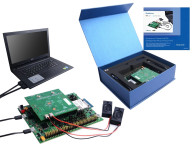ARM has introduced Cortex-R8, it’s latest quad-core real-time processor, designed for implementation on advanced silicon processes with an emphasis on improved energy efficiency, real-time responsiveness, advanced features and ease of system design. Next generation LTE Advanced Pro and 5G mobile baseband standards and mass storage applications will benefit from ARM’s new Cortex-R8 processor.

The new ARM Cortex-R8 processor will enable chip designers to double the performance of ARM-based modem and mass storage device SoCs. ARM’s latest real-time CPU offers the low latency, high performance and power efficiency demanded by future 5G modems and mass storage devices. The processor is available for licensing now and silicon is expected in 2016.
A quad-core configuration dramatically boosts the total Cortex-R8 performance, which when combined with its real time features and extended low-latency memory makes Cortex-R8 the highest performing processor in its class. The new processor provides a flexible local memory system that supports large Tightly Coupled Memory (TCM), local shared memory, a shared coherent peripheral port, and a per core fast path port, enabling SoC designers to reach the most demanding real-time requirements within constrained silicon resources.
The new flagship ARM processor features an 11-stage, superscalar, out-of-order pipeline with advanced dynamic and static branch prediction, dynamic register re-naming and non-blocking Load-Store Unit. It provides an integrated Generic Interrupt Controller (GIC), Snoop Control Unit (SCU) and timers to further reduce latency and enable symmetric multiprocessing in a dual core configuration. Additional features include enhanced error detection and correction capabilities to ensure data integrity, and flexible MP1, MP2, MP3 or MP4 core configurations, with the option of a lock-step configuration with redundant processor, Symmetric Multi-Processing (SMP) and Asymmetric Multi-Processing (AMP).
“5G will revolutionize mobile communications as it delivers the ability to significantly increase data rates, offering a far better mobile experience,” says James McNiven, general manager, CPU Group, ARM. “The Cortex-R8 is the most powerful real-time CPU available and its unrivaled performance will make it instrumental in the creation of 5G modems. It will form the communications heart of future smartphones, tablets, connected cars and IoT.”

LTE-Advanced Pro and 5G are expected to meet the requirements of ever increasing high data rates, low latency, and a large increase in machine-to-machine and IoT communications. These requirements combined with increased carrier aggregation, efficient use of fragmented spectrum, and continued energy efficiency place significant demands on future modems.
Cortex-R8 based SoCs enable future modems to meet the demand for more efficient and scalable performance by employing a quad-core CPU configuration, coherency system and rich set of memory and peripheral interfaces. Cortex-R8 delivers the scalable performance, low power, fast and highly deterministic interrupt response times and extremely low-latency interfaces which will be required in all future mobile broadband devices.
The Cortex-R8 extends the company’s range by providing mass storage controller developers with the performance, capability and efficiency vital for higher capacity and faster data rates in hard and solid state drives across enterprise and consumer storage solutions. Cortex-R8 enables this in a highly efficient way by dynamically scaling performance as workload changes. The Cortex-R8 includes a range of very low latency dedicated interfaces that help ensure performance is extended through the SoC system.
ARM has been the number one CPU architecture in cellular modems since the first generation of GSM devices in the 1990s. It has formed the backbone of more than 20 billion cellular devices worldwide and continues to do so in the latest smartphones and connected IoT products unveiled at the Mobile World Congress 2016 in Barcelona.
ARM silicon partners have already begun design work. SoCs based on the Cortex-R8 targeting the mass storage market segment are likely to be available in 2016. Modem designs using Cortex-R8 processors will support the rollout of the new LTE-Advanced Pro and 5G standards. The Cortex-R8 is also compatible with existing software so design cycles will be reduced, allowing developers to extend their real-time product ranges based on a single CPU architecture.
www.arm.com






